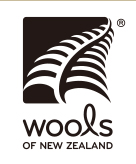SUPPORT
 The Wools of New Zealand Brand signifies more than just the use of New Zealand wool. Manufacturers are licensed by Wools of New Zealand only after their products and production methods have been checked and approved. Carpets are subject to up to 23 demanding laboratory tests, and the manufacturer guarantees to supply carpets that meet the standards for all production.
The Wools of New Zealand Brand signifies more than just the use of New Zealand wool. Manufacturers are licensed by Wools of New Zealand only after their products and production methods have been checked and approved. Carpets are subject to up to 23 demanding laboratory tests, and the manufacturer guarantees to supply carpets that meet the standards for all production.
Quality controls are checked in the mill, and random testing is also carried out by Wools of New Zealand. World-wide only about 150 of the world’s leading manufacturers are licensed to use the brand. For an up to date list, visit www.woolcarpets.com.
The Wools of New Zealand standards include minimum requirements for:
- wool content (at least 80%) and New Zealand wool content
- appearance retention
- durability
- soiling
- insect resistance
- colour fastness (light, shampoo, rubbing, water)
- tuft bind
- backing strength (where applicable)
- stair suitability
New Zealand wool is the worldÕs favourite carpet fibre. The sheep in New Zealand have been specially bred to produce the perfect carpet wool, and New ZealandÕs clean natural environment ensures 40 million strong healthy sheep produce strong healthy wool.

Wool fibres have a unique and complex combination of properties that make them the ideal carpet fibre. After decades of development, synthetic fibres still cannot match the all-round high standard of pure, natural wool. After all, how do you make a chemical fibre that:
- is 100% natural
- naturally resists soiling
- has excellent soil release
- takes dyes to it’s heart for rich, bright colours
- resists flattening like a spring
- self-straightens after crushing
- absorbs and releases up to 33% moisture to control humidity
- is tough and durable
- is extremely fire-safe
- is biodegradable
- feels soft and luxurious
When it comes to the environment, wool carpets are exceptional – as you would expect from a natural fibre.  Wool fibres absorb a wide range of pollutant gasses from the atmosphere, permanently. The air in a wool-carpeted room will be fresher and cleaner, a subtle but important factor.
Wool fibres absorb a wide range of pollutant gasses from the atmosphere, permanently. The air in a wool-carpeted room will be fresher and cleaner, a subtle but important factor.
Wool carpets absorb sound, creating a more peaceful environment, important in guest rooms, bedrooms, meeting rooms, restaurants, in fact any busy area.
Wool carpets will absorb moisture and release heat during higher humidity, cool periods (such as at night) and release it again, and provide a cooling effect during warmer periods, such as during the day. Only wool has such a pronounced air-conditioning effect.
Wool carpets have been shown to be safe and non allergenic. Dust mites will not survive in a wool carpet,and dust particles are trapped in the pile.Carpet is better than hard flooring at reducing dust in the environment.
Wool carpets are naturally anti-static, due to their moisture-absorbing qualities. In addition, anti-static treatments are routinely applied by manufacturers, and are a requirement for contract carpets. New Zealand sheep farmers meet the world’s strict requirements for delivering chemical free, humanely grown pure natural wool. Occasionally, necessary animal health remedies are used which are approved and safe, and are completely removed from the wool during processing.
Dyes used to make wool carpets are industry-standard, and modern processes ensure pollution free processing.
Wool carpets are insect resistant when treated to Wools of New Zealand standards. Tiny amounts of environmentally safe, approved insecticides are permanently added during dyeing to ensure no insects will damage the carpet.
Wool is bio-degradable, breaking down to nitrogen-rich soil nutrients.
Polluted indoor air can lead to discomfort, reduced efficiency and even ill health amongst employees and residents in buildings.
Wool carpet has been shown to rapidly neutralise formaldehyde, nitrogen dioxide and sulphur dioxide, common contaminants in today’s indoor environment.
Not only does wool neutralise these contaminants more quickly and completely than synthetic carpet fibres, it does not re-emit them, even when heated.
Wool carpet may continue purifying the air for up to 30 years.

Research by AgResearch scientists has revealed that wool carpets play a significant role in reducing the levels of common indoor air contaminants in buildings.
Indoor air pollution is seen as the primary cause of Sick Building Syndrome (SBS), resulting in reduced efficiency and increased instances of ill health amongst employees and other building occupants.
The issue of indoor air quality is receiving increasing attention as a public health concern because people spend a much higher proportion of their time indoors. The problem is exacerbated by the tendency for modern buildings to have air conditioning, which requires a semi-sealed environment to operate efficiently. This, in effect, traps the pollutants inside.
Carpet must look like new for its useful life. Dirty, flat or stained carpet is simply not acceptable by today’s discerning customers. Wool’s special construction does it all.

The rough scale structure on the surface of the fibres hides soil and slows it’s penetration into the carpet- and releases it easily to vacuuming.
The scales are hard, and resist damage by grit, and hide scratches.
The waterproof surface of the fibres resists staining.
The water-vapour absorbent core of the fibres force the fibres to straighten, so pile flattening just disappears overnight or with wet cleaning.
The keratin proteins and moisture content in wool make it naturally flame-resistant, and self extinguishing. Cigarette burns just brush away.

 繁體中文
繁體中文